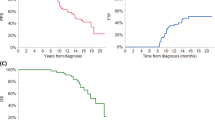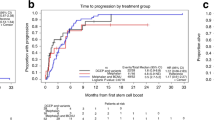Summary:
Autologous stem cell transplant (SCT) improves survival in multiple myeloma (MM) and remains the standard of care for eligible patients. Nearly a third of patients with newly diagnosed MM fail initial therapy aimed at reducing tumor burden preceding SCT (primary refractory). It is unclear if an initial response is important for successful SCT. We evaluated our experience with SCT in 50 patients with primary refractory MM and compared it to 101 patients with chemosensitive disease receiving SCT. The study cohort had a median age of 56 years (range 29–72) consisting of 87 males (58%). A total of 46 patients (92%) in the refractory group and 100 (99%) in the chemosensitive group had a response to transplant (50% or greater reduction in the M-protein). In all, 10 refractory patients (20%) and 35 (35%) in the chemosensitive group achieved a CR (P=0.06). The 1-year estimated progresion-free survival from the time of transplant for the refractory group was 70% compared to 83% for the chemosensitive group (P=0.65). The lack of response to initial induction therapy does not appear to preclude a good response to SCT. We recommend that patients with primary refractory MM be offered early SCT.
This is a preview of subscription content, access via your institution
Access options
Subscribe to this journal
Receive 12 print issues and online access
$259.00 per year
only $21.58 per issue
Buy this article
- Purchase on Springer Link
- Instant access to full article PDF
Prices may be subject to local taxes which are calculated during checkout

Similar content being viewed by others
References
Bataille R, Harousseau JL . Multiple myeloma. New Engl J Med 1997; 336: 1657–1664.
Jemal A, Murray T, Samuels A et al. Cancer statistics, 2003. CA Cancer J Clin 2003; 53: 5–26.
Kyle RA . Long-term survival in multiple myeloma. New Engl J Med 1983; 308: 314–316.
Alexanian R, Bonnet J, Gehan E et al. Combination chemotherapy for multiple myeloma. Cancer 1972; 30: 382–389.
Kyle R, Gertz M, Witzig T et al. Review of 1027 patients with newly diagnosed multiple myeloma. Mayo Clin Proc 2003; 78: 21–33.
Child JA, Morgan GJ, Davies FE et al. High-dose chemotherapy with hematopoietic stem-cell rescue for multiple myeloma. N Engl J Med 2003; 348: 1875–1883.
Attal M, Harousseau JL, Stoppa AM et al. A prospective, randomized trial of autologous bone marrow transplantation and chemotherapy in multiple myeloma. Intergroupe Francais du Myelome. [see comments.]. N Engl J Med 1996; 335: 91–97.
Lenhoff S, Hjorth M, Holmberg E et al. Impact on survival of high-dose therapy with autologous stem cell support in patients younger than 60 years with newly diagnosed multiple myeloma: a population-based study. Nordic Myeloma Study Group. Blood 2000; 95: 7–11.
Barlogie B, Jagannath S, Desikan KR et al. Total therapy with tandem transplants for newly diagnosed multiple myeloma. Blood 1999; 93: 55–65.
Attal M, Harousseau J, Facon T et al. Double autologous transplantation improves survival of multiple myeloma patients: final analysis of a prospective Randomized Study of the “Intergroupe Francophone du Myelome” (IFM 94) [abstract]. Blood 2002; 100 Abstract # 7.
Vose JM, Anderson JR, Kessinger A et al. High-dose chemotherapy and autologous hematopoietic stem-cell transplantation for aggressive non-Hodgkin's lymphoma. J Clin Oncol 1993; 11: 1846–1851.
Stewart FM . Indications and relative indications for stem cell transplantation in non-Hodgkin's lymphoma. Leukemia 1993; 7: 1091–1094.
Rajkumar SV, Fonseca R, Lacy MQ et al. Autologous stem cell transplantation for relapsed and primary refractory myeloma. Bone Marrow Transplant 1999; 23: 1267–1272.
Alexanian R, Dimopoulos MA, Delasalle KB et al. Myeloablative therapy for primary resistant multiple myeloma. Stem Cells 1995; 13 (Suppl 2): 118–121.
Barlogie B, Smith L, Alexanian R . Effective treatment of advanced multiple myeloma refractory to alkylating agents. N Engl J Med 1984; 310: 1353–1356.
Blade J, Samson D, Reece D et al. Criteria for evaluating disease response and progression in patients with multiple myeloma treated by high-dose therapy and haemopoietic stem cell transplantation. Myeloma Subcommittee of the EBMT. European Group for Blood and Marrow Transplant. Br J Haematol 1998; 102: 1115–1123.
Greipp PR, Lust JA, O'Fallon WM et al. Plasma cell labeling index and beta 2-microglobulin predict survival independent of thymidine kinase and C-reactive protein in multiple myeloma. Blood 1993; 81: 3382–3387.
Kaplan E, Meier P . Non-parametric estimation from incomplete observations. J Am Stat Assoc 1958; 53: 457–481.
Cox D . Regression models and life tables. J R Stat Soc 1972; 34: 187–202.
McElwain TJ, Powles RL . High-dose intravenous melphalan for plasma-cell leukaemia and myeloma. Lancet 1983; 2: 822–824.
Barlogie B, Hall R, Zander A et al. High-dose melphalan with autologous bone marrow transplantation for multiple myeloma. Blood 1986; 67: 1298–1301.
Barlogie B, Jagannath S, Vesole DH et al. Superiority of tandem autologous transplantation over standard therapy for previously untreated multiple myeloma. Blood 1997; 89: 789–793.
Blade J, Esteve J, Rives S et al. High-dose therapy autotransplantation/intensification vs continued standard chemotherapy in multiple myeloma in first remission. Results of a non-randomized study from a single institution. Bone Marrow Transplant 2000; 26: 845–849.
Knudsen LM, Rasmussen T, Jensen L, Johnsen HE . Reduced bone marrow stem cell pool and progenitor mobilisation in multiple myeloma after melphalan treatment. Med Oncol 1999; 16: 245–254.
Powles R, Sirohi B, Kulkarni S et al. Collection of peripheral blood stem cells in newly diagnosed myeloma patients without any prior cytoreductive therapy: the first step towards an ‘operational cure’? Bone Marrow Transplant 2002; 30: 479–484.
Singhal S, Powles R, Sirohi B et al. Response to induction chemotherapy is not essential to obtain survival benefit from high-dose melphalan and autotransplantation in myeloma. Bone Marrow Transplant 2002; 30: 673–679.
Fermand JP, Ravaud P, Chevret S et al. High-dose therapy and autologous peripheral blood stem cell transplantation in multiple myeloma: up-front or rescue treatment* Results of a multicenter sequential randomized clinical trial. Blood 1998; 92: 3131–3136.
Alexanian R, Weber D, Delasalle K et al. Value of intensive therapy supported by autologous stem cells (IT+ASCT) for primary resistant multiple myeloma. Blood 2002; 100 abstract: #672.
Alexanian R, Dimopoulos MA, Hester J et al. Early myeloablative therapy for multiple myeloma. Blood 1994; 84: 4278–4282.
Blade J, Esteve J . Treatment approaches for relapsing and refractory multiple myeloma. Acta Oncol 2000; 39: 843–847.
Dimopoulos MA, Hester J, Huh Y et al. Intensive chemotherapy with blood progenitor transplantation for primary resistant multiple myeloma. Br J Haematol 1994; 87: 730–734.
Jagannath S, Barlogie B, Dicke K et al. Autologous bone marrow transplantation in multiple myeloma: identification of prognostic factors. Blood 1990; 76: 1860–1866.
Vesole DH, Barlogie B, Jagannath S et al. High-dose therapy for refractory multiple myeloma: improved prognosis with better supportive care and double transplants. Blood 1994; 84: 950–956.
Schenkein DP, Koc Y, Alcindor T et al. Treatment of primary resistant or relapsed multiple myeloma with high-dose chemoradiotherapy, hematopoietic stem cell rescue, and granulocyte-macrophage colony-stimulating factor. Biol Blood Marrow Transplant 2000; 6: 448–455.
Rajkumar SV, Fonseca R, Lacy MQ et al. Beta2-microglobulin and bone marrow plasma cell involvement predict complete responders among patients undergoing blood cell transplantation for myeloma. Bone Marrow Transplant 1999; 23: 1261–1266.
Gertz MA, Witzig TE, Pineda AA et al. Monoclonal plasma cells in the blood stem cell harvest from patients with multiple myeloma are associated with shortened relapse-free survival after transplantation. Bone Marrow Transplant 1997; 19: 337–342.
Rajkumar SV, Fonseca R, Dispenzieri A et al. Effect of complete response on outcome following autologous stem cell transplantation for myeloma. Bone Marrow Transplant 2000; 26: 979–983.
Harousseau JL, Attal M, Divine M et al. Autologous stem cell transplantation after first remission induction treatment in multiple myeloma. A report of the French Registry on autologous transplantation in multiple myeloma. Stem Cells 1995; 13 (Suppl 2): 132–139.
Shimoni A, Smith TL, Aleman A et al. Thiotepa, busulfan, cyclophosphamide (TBC) and autologous hematopoietic transplantation: an intensive regimen for the treatment of multiple myeloma. Bone Marrow Transplant 2001; 27: 821–828.
Vesole DH, Tricot G, Jagannath S et al. Autotransplants in multiple myeloma: what have we learned? Blood 1996; 88: 838–847.
Acknowledgements
This study was supported in part by Hematological Malignancies Fund, Mayo Clinic and CA62242 from the National Cancer Institute.
Author information
Authors and Affiliations
Corresponding author
Rights and permissions
About this article
Cite this article
Kumar, S., Lacy, M., Dispenzieri, A. et al. High-dose therapy and autologous stem cell transplantation for multiple myeloma poorly responsive to initial therapy. Bone Marrow Transplant 34, 161–167 (2004). https://doi.org/10.1038/sj.bmt.1704545
Received:
Accepted:
Published:
Issue Date:
DOI: https://doi.org/10.1038/sj.bmt.1704545
Keywords
This article is cited by
-
Should I stay or should I go (to transplant)? Managing insufficient responses to induction in multiple myeloma
Blood Cancer Journal (2023)
-
Phase I study of samalizumab in chronic lymphocytic leukemia and multiple myeloma: blockade of the immune checkpoint CD200
Journal for ImmunoTherapy of Cancer (2019)
-
Impact of Pre-transplant and Post-transplant Remission Status of Patients on Survival in Newly Diagnosed Multiple Myeloma
Indian Journal of Hematology and Blood Transfusion (2019)
-
Prognostic significance of normalized FDG-PET parameters in patients with multiple myeloma undergoing induction chemotherapy and autologous hematopoietic stem cell transplantation: a retrospective single-center evaluation
European Journal of Nuclear Medicine and Molecular Imaging (2019)
-
Utilization of hematopoietic stem cell transplantation for the treatment of multiple myeloma: a Mayo Stratification of Myeloma and Risk-Adapted Therapy (mSMART) consensus statement
Bone Marrow Transplantation (2019)



